LaTeX Typesetting
Overview of common eye-tracking measures
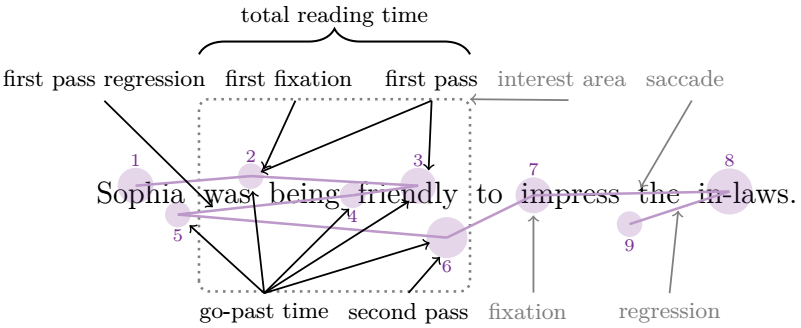
A depiction of common eye-tracking measures (total reading time, first
pass regression, first fixation duration, first pass reading time,
go-past time, second pass reading time), as well as a single fixation,
regression, saccade, and interest area. Please, cite this figure as:
Prysłopska, Anna (2021). Being Friendly is Difficult: Psycholinguistic
Experiments on Agentivity in Copular Constructions. PhD thesis,
University of Tübingen.
\usetikzlibrary
\definecolor
\begin{document}
\tikzset
\tikzset
\tikzset
\tikzset
\tikzset
\begin{tikzpicture}
% BOX
\draw[draw=gray, rounded corners, dotted, line width=1pt, opacity=1] (-254,-50) rectangle ++(141,100);
% SENTENCE
\draw (-125,0) node [font=\large] ;
% CIRCLES
\draw [circle] (-287,5) circle (.7em) node (1);
\draw [circle] (-227,10) circle (0.5em) node (2);
\draw [circle] (-140,5) circle (0.7em) node (3);
\draw [circle] (-174,0) circle (0.5em) node (4);
\draw [circle] (-265,-10) circle (0.5em) node (5);
\draw [circle] (-125,-22) circle (0.8em) node (6);
\draw [circle] (-80,0) circle (0.7em) node (7);
\draw [circle] (22,2) circle (0.9em) node (8);
\draw [circle] (-30,-15) circle (.5em) node (9);
% TEXT
\draw [numbers] node [above = 0 em of 1, anchor=south] ;
\draw [numbers] node [above = -0.2em of 2, anchor=south] ;
\draw [numbers] node [above = -0em of 3, anchor=south] ;
\draw [numbers] node [below = -0.2em of 4, anchor=north] ;
\draw [numbers] node [below = -0.2em of 5, anchor=north] ;
\draw [numbers] node [below = 0.1em of 6, anchor=north] ;
\draw [numbers] node [above = 0em of 7, anchor=south] ;
\draw [numbers] node [above = .2em of 8, anchor=south] ;
\draw [numbers] node [below = -0.2em of 9, anchor=north] ;
\draw [annotation] node [below = 5 em of 7, anchor=south] (fixation) ;
\draw [annotation] node [left = 0 em of fixation] (SPRT) ;
\draw [annotation] node [left = 0 em of SPRT] (RPD) ;
\draw [annotation] node [right = 0.8em of fixation] (regression) ;
\draw [annotation] node [above = 7.5em of SPRT, xshift=0.9em] (FPRT) ;
\draw [annotation] node [left = 0em of FPRT] (FF) ;
\draw [annotation] node [left = 0em of FF] (FPR) ;
\draw [thick, decorate, decoration=, yshift=2.5em] (-254,40) -- (-113,40) node [black,midway,yshift=1.5em] (TRT) ;
\draw [annotation] node [right = 0 em of FPRT] (IA) ;
\draw [annotation] node [right = -0.5 em of IA] (saccade) ;
% LINES
\draw [color=darkpurple!50] (1.center) -- (2.center) node [midway] (A) ;
\draw [color=darkpurple!50] (2.center) -- (3.center) ;
\draw [color=darkpurple!50] (3.center) -- (4.center) node [midway] (C) ;
\draw [color=darkpurple!50] (4.center) -- (5.center) node [midway] (D) ;
\draw [color=darkpurple!50] (5.center) -- (6.center) ;
\draw [color=darkpurple!50] (6.center) -- (7.center) ;
\draw [color=darkpurple!50] (7.center) -- (8.center) node [midway] (E) ;
\draw [color=darkpurple!50] (8.center) -- (9.center) node [midway] (B) ;
% ARROWS
\draw [->, draw=gray, arrow, shorten >=.4em] (fixation) -- (7.south);
\draw [->, draw=gray, arrow, shorten >=.7em] (saccade.south) -- (E.south);
\draw [->, draw=gray, arrow, shorten >=0em] (IA.south) -- (-113,50);
\draw [->, draw=gray, arrow, shorten >=.5em] (regression.north) -- (B.north) ;
\draw [->, arrow, shorten >=0em] (FPRT.south) -- (2);
\draw [->, arrow, shorten >=.6em] (FPRT.south) -- (3.east);
\draw [->, arrow, shorten >=1em] (SPRT.north) -- (6.east);
\draw [->, arrow, shorten >=.2em] (RPD.north) -- (2);
\draw [->, arrow, shorten >=.4em] (RPD.north) -- (3.south);
\draw [->, arrow, shorten >=.2em] (RPD.north) -- (4.south);
\draw [->, arrow, shorten >=.1em] (RPD.north) -- (5);
\draw [->, arrow, shorten >=.3em] (RPD.north) -- (6);
\draw [->, arrow, shorten >=.3em] (FF.south) -- (2.east);
\draw [->, arrow, shorten >=.3em] (FPR.south) -- (-244,-9);
\end{tikzpicture}
\end{document}
Eye-tracking trial structure

An outline of the procedure in a single eye-tracking trial. Please, cite
this figure as:
Prysłopska, Anna (2021). Being Friendly is Difficult: Psycholinguistic
Experiments on Agentivity in Copular Constructions. PhD thesis,
University of Tübingen.
\usetikzlibrary
\begin{document}
\tikzset
\begin{tikzpicture}
% Boxes
\node [block] (calibration) ;
\draw () node ;
\draw () node ;
\node [block, right = of calibration] (point) ;
\node [block, right = 1em of point] (sentence) ;
\node [block, right = 1em of sentence] (question) ;
\node [block, right = 1em of question] (next) ;
% Descriptions
\node [above = 0.1em of calibration] (cal) ;
\node [above = 0.1em of point] (fix) ;
\node [above = 0.1em of sentence] (sen) ;
\node [above = -0.1em of question] (que) ;
\node [above = 0.1em of next] (nex) ;
% Arrows
%% Straight
\draw [arrow, shorten >= 2pt] (calibration) to (point);
%% Bendy below
\draw [arrow, shorten >= 2pt] (point.south) to [bend right=20] node[midway,below] (sentence.south);
\draw [arrow, shorten >= 2pt] (sentence.south) to [bend right=20] node[midway,below] (question.south);
\draw [arrow, shorten >= 2pt] (sentence.south) to [bend right=48] node[midway,above] (next.south);
\draw [arrow, shorten >= 2pt] (question.south) to [bend right=20] (next.south);
\draw [arrow, rounded corners=9, shorten >= 2pt] (next.east) -- ++(0.3,0) -- ++(0,-2.4) -| (point.south);
%% Bendy above
\draw [arrow, dashed, shorten >= 2pt] (fix.north) to [bend right=20] node[midway,above] (cal.north);
\draw [arrow, dashed] (sen.north) to [bend left=10] node[midway,above] (nex.north);
\draw [arrow, dashed, rounded corners=9] (nex.north) -- ++(0,0.8) -| (cal.north);
% Trial marking
\begin{scope}
\draw[draw=none, rounded corners=9pt,fill=gray!15] () rectangle ();
\node [below = 2.8em of calibration, xshift=2.7em] (trial) ;
\end{scope}
\end{tikzpicture}
\end{document}
Git workflow
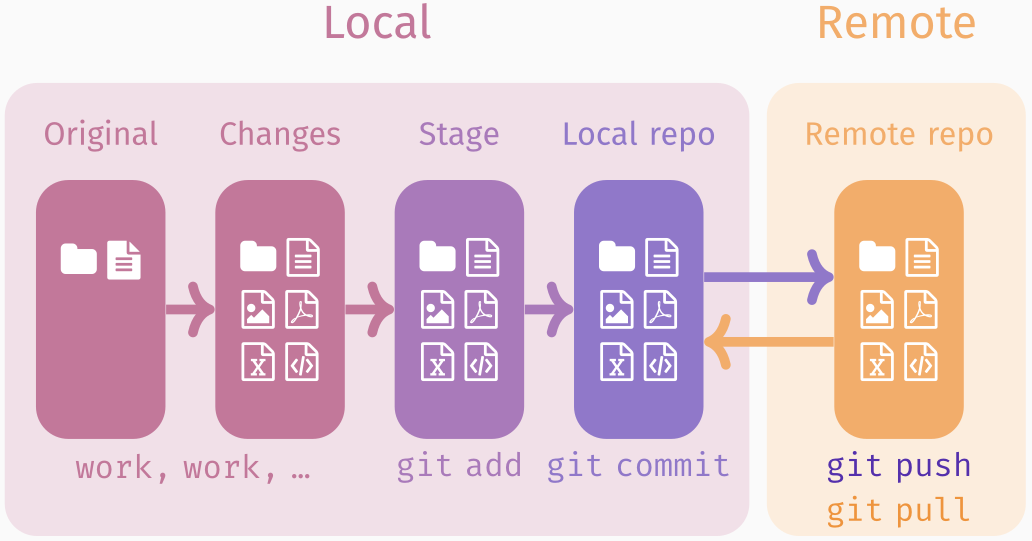
\usetikzlibrary
\definecolor
\definecolor
\definecolor
\tikzset
\tikzset
\begin{document}
\begin{tikzpicture}
\node [block, fill=fancypink!15, minimum width = 23em, minimum height=14em] (LOC) at (0,0) ; % Local
\node [block, fill=orange!15, right = 0.5em of LOC, minimum height=14em, minimum width = 8em] (REM) ; % Remote
\node [annotation, above = 1em of LOC, font=\Large\bfseries\sffamily] ;
\node [annotation, above = 1em of REM, font=\Large\bfseries\sffamily] ;
\node [block, fill=fancypink!65] (ORI) at (-3,0) ;
\node [block, right = of ORI, fill=fancypink!65] (CHA) ;
\node [annotation, above = 0.5em of ORI, font=\normalsize\bfseries\sffamily] ;
\node [annotation, above = 0.5em of CHA, font=\normalsize\bfseries\sffamily] ;
\node at (-2,0) (MID);
\draw [->, line width=3pt, draw=fancypink!65] (ORI.east) -- (CHA.west);
\node [annotation, below = 3.75em of MID, font=\normalsize] ;
\node [block, right = of CHA, fill=darkpurple!65] (STA) ;
\node [annotation, above = 0.5em of STA, font=\normalsize\bfseries\sffamily] ;
\draw [->, line width=3pt, draw=fancypink!65] (CHA.east) -- (STA.west);
\node [annotation, below = 0em of STA, font=\normalsize] ;
\node [block, right = of STA, fill=fancypurple!65] (COM) ;
\node [annotation, above = 0.5em of COM, font=\normalsize\bfseries\sffamily] ;
\draw [->, line width=3pt, draw=darkpurple!65] (STA.east) -- (COM.west);
\node [annotation, below = 0em of COM, font=\normalsize] ;
\node [block, right = 4em of COM, fill=orange!65] (PUS) ;
\node [annotation, above = 0.5em of PUS, font=\normalsize\bfseries\sffamily] ;
\draw [->, line width=3pt, draw=fancypurple!65, transform canvas=] (COM.east) -- (PUS.west);
\draw [->, line width=3pt, draw=orange!65, transform canvas=] (PUS.west) -- (COM.east);
\node [annotation, below = 0em of PUS, font=\normalsize] ;
\end{tikzpicture}
\end{document}
Tree structure
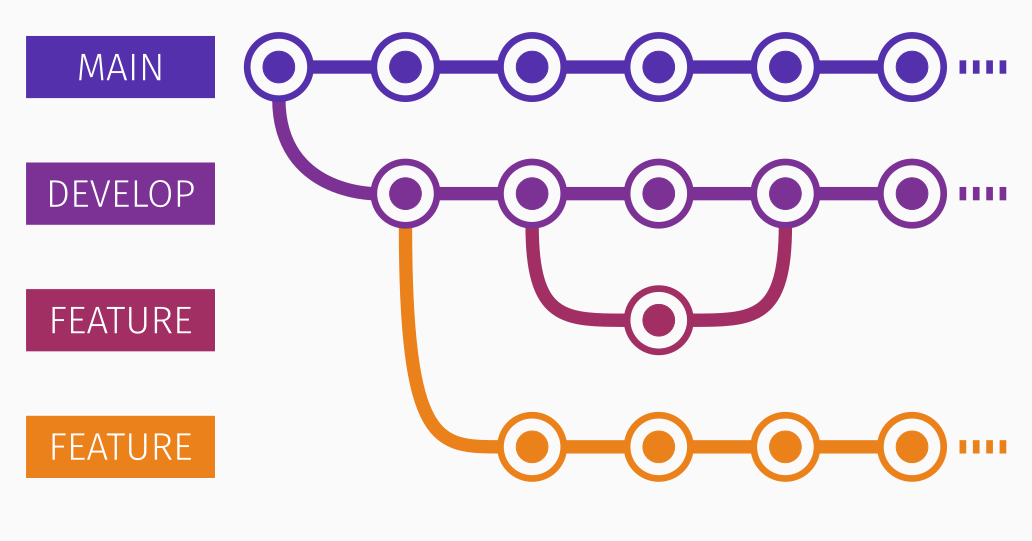
\usetikzlibrary
\definecolor
\definecolor
\definecolor
\definecolor
\begin{document}
\begin{circuitikz}
\tikzstyle=[font=\LARGE]
\draw [ color=darkpurple, line width=6, short] (0,-.5) .. controls (0,-2) and (1.5, -2) .. (1.5, -2);
\draw [ color=orange, line width=6, short] (2,-2.5) .. controls (2,-6) and (2.5, -6) .. (3.5, -6);
\draw [ color=fancypink, line width=6, short] (4,-2.5) .. controls (4,-4) and (4.5, -4) .. (5.5, -4);
\draw [ color=fancypink, line width=6, short] (8,-2.5) .. controls (8,-4) and (7.5, -4) .. (6.5, -4);
\draw [ color=white , fill=fancypurple] (-4, -0.5) rectangle node (-1, 0.5);
\draw [color=fancypurple, line width=6, short] (0.5, 0) -- (1.5, 0);
\draw [color=fancypurple, line width=6, short] (2.5, 0) -- (3.5, 0);
\draw [color=fancypurple, line width=6, short] (4.5, 0) -- (5.5, 0);
\draw [color=fancypurple, line width=6, short] (6.5, 0) -- (7.5, 0);
\draw [color=fancypurple, line width=6, short] (8.5, 0) -- (9.5, 0);
\draw [dashed, color=fancypurple, line width=6] (10.75, 0) -- (11.5, 0);
\draw [color=fancypurple, line width=3] (0,0) circle (0.5cm);
\draw [fill=fancypurple, color=fancypurple] (0,0) circle (0.25cm);
\draw [color=fancypurple, line width=3] (2,0) circle (0.5cm);
\draw [fill=fancypurple, color=fancypurple] (2,0) circle (0.25cm);
\draw [color=fancypurple, line width=3] (4,0) circle (0.5cm);
\draw [fill=fancypurple, color=fancypurple] (4,0) circle (0.25cm);
\draw [color=fancypurple, line width=3] (6,0) circle (0.5cm);
\draw [fill=fancypurple, color=fancypurple] (6,0) circle (0.25cm);
\draw [color=fancypurple, line width=3] (8,0) circle (0.5cm);
\draw [fill=fancypurple, color=fancypurple] (8,0) circle (0.25cm);
\draw [color=fancypurple, line width=3] (10,0) circle (0.5cm);
\draw [fill=fancypurple, color=fancypurple] (10,0) circle (0.25cm);
\draw [ color=white , fill=darkpurple] (-4, -1.5) rectangle node (-1, -2.5);
\draw [color=darkpurple, line width=6, short] (2.5, -2) -- (3.5, -2);
\draw [color=darkpurple, line width=6, short] (4.5, -2) -- (5.5, -2);
\draw [color=darkpurple, line width=6, short] (6.5, -2) -- (7.5, -2);
\draw [color=darkpurple, line width=6, short] (8.5, -2) -- (9.5, -2);
\draw [dashed, color=darkpurple, line width=6] (10.75, -2) -- (11.5, -2);
\draw [color=darkpurple, line width=3] (2,-2) circle (0.5cm);
\draw [fill=darkpurple, color=darkpurple] (2,-2) circle (0.25cm);
\draw [color=darkpurple, line width=3] (4,-2) circle (0.5cm);
\draw [fill=darkpurple, color=darkpurple] (4,-2) circle (0.25cm);
\draw [color=darkpurple, line width=3] (6,-2) circle (0.5cm);
\draw [fill=darkpurple, color=darkpurple] (6,-2) circle (0.25cm);
\draw [color=darkpurple, line width=3] (8,-2) circle (0.5cm);
\draw [fill=darkpurple, color=darkpurple] (8,-2) circle (0.25cm);
\draw [color=darkpurple, line width=3] (10,-2) circle (0.5cm);
\draw [fill=darkpurple, color=darkpurple] (10,-2) circle (0.25cm);
\draw [color=fancypink, line width=3] (6,-4) circle (0.5cm);
\draw [fill=fancypink, color=fancypink] (6,-4) circle (0.25cm);
\draw [ color=white , fill=fancypink] (-4, -4.5) rectangle node (-1, -3.5);
\draw [color=orange, line width=3] (4,-6) circle (0.5cm);
\draw [fill=orange, color=orange] (4,-6) circle (0.25cm);
\draw [color=orange, line width=3] (6,-6) circle (0.5cm);
\draw [fill=orange, color=orange] (6,-6) circle (0.25cm);
\draw [color=orange, line width=3] (8,-6) circle (0.5cm);
\draw [fill=orange, color=orange] (8,-6) circle (0.25cm);
\draw [color=orange, line width=3] (10,-6) circle (0.5cm);
\draw [fill=orange, color=orange] (10,-6) circle (0.25cm);
\draw [ color=white , fill=orange] (-4, -6.5) rectangle node (-1, -5.5);
\draw [color=orange, line width=6, short] (4.5, -6) -- (5.5, -6);
\draw [color=orange, line width=6, short] (6.5, -6) -- (7.5, -6);
\draw [color=orange, line width=6, short] (8.5, -6) -- (9.5, -6);
\draw [dashed, color=orange, line width=6] (10.75, -6) -- (11.5, -6);
\end{circuitikz}
\end{document}
Aspectual transition network

Adapted from Moens and Steedman (1988) and Steedman (2011).
\usetikzlibrary
\tikzset
\begin{document}
\begin{tikzpicture}
% Grid
\draw[black, thick] (-2.5, 3.8) -- (10.3,3.8); % top
\draw[black, thick] (-2.5, -6.4) -- (-2.5, 3.8); % left
\draw[black, thick] (-2.5, -6.4) -- (10.3, -6.4); % bottom
\draw[black, thick] (10.3, -6.4) -- (10.3, 3.8); %right
\draw[black, thick] (6.5, -4) -- (6.5, 3.8);% middle top
\draw[black, thick] (6.5, -6.4) -- (6.5, -4.7);% middle bottom
\draw[black, ultra thin] (-1.8, -6.4) -- (-1.8, 3.1);
\draw[black, ultra thin] (-1.8, 3.1) -- (6.5, 3.1);
\draw[gray, dashed, ultra thin] (-1.8,-1.8) -- (6.5,-1.8);
\draw[gray, dashed, ultra thin] (1.85, -6.4) -- (1.85, 3.1);
% Events
\node [block] (ach) ;
\node [block, below of = ach] (poi) ;
\node [block, right = 2em of ach] (acc) ;
\node [block, below of = acc] (act) ;
\node [above = 8em of ach] (-co) ;
\node [above = 8em of acc] (+co) ;
\node [above right=0.5em and -0.5em of -co] (eve) ;
\node [rotate=90, above left = 1em and 1.2em of ach] (+te) ;
\node [rotate=90, left of = +te] (-te) ;
% States
\node [block, right =3.4em of acc] (con) ;
\node [block, above = 3.6em of con] (lex) ;
\node [above = 4.4em of lex] (sta) ;
\node [block, below of = con] (pro) ;
\node [block, below = 3.6em of pro] (hab) ;
% Arrows
\draw[->, postaction=] (ach) to [bend left=25] (poi);
\draw[->, postaction=] (poi) to [bend left=25] (ach);
\draw[->, postaction=] (ach) to [bend left=35] (acc);
\draw[->, postaction=] (poi) to [bend right=35] (act);
\draw[->] (act) to [bend right=35] (poi);
\draw[->, postaction=] (acc) to [bend left=25] (act);
\draw[->, postaction=] (acc) to [bend left=25] (act);
\draw[->, postaction=] (act) to [bend left=25] (acc);
\draw[->] (acc) to (poi);
\draw[->, postaction=] (ach) to [bend left=50] (con);
\draw[->, postaction=] (ach) to [bend left=50] (con);
\draw[->, postaction=] (act) to [bend right=30] (pro);
\draw[->, postaction=] (act) to [bend right=30] (pro);
\draw[->, postaction=] (poi) to [bend right=27] (hab);
\end{tikzpicture}
\end{document}
Coercion framework
The coercion framework adapted from Dölling (2014). Arrows indicate the shifting direction in cases where bidirectional coercion is possible.
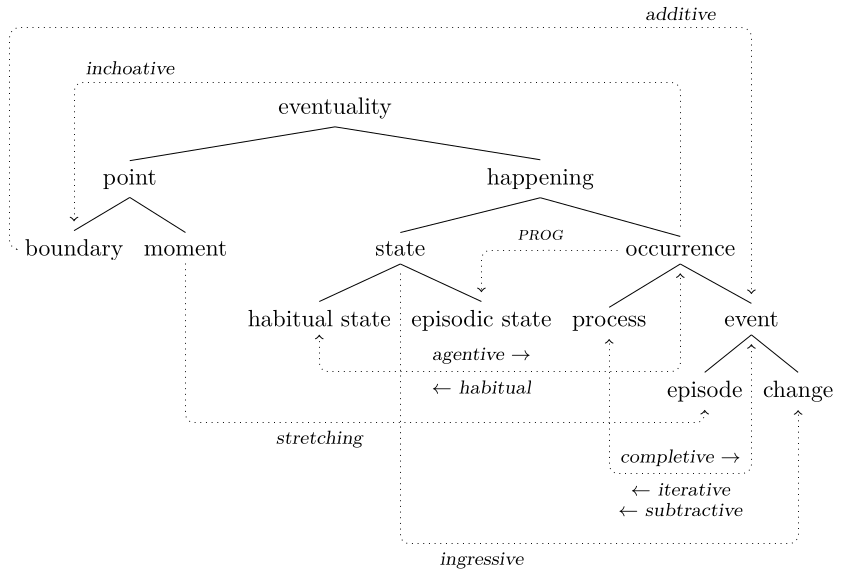
\usetikzlibrary
\tikzset
\begin{document}
\begin{tikzpicture}
% Tree
\Tree [.\node(eventuality);
[.\node(point);
[.\node(boundary); ]
[.\node(moment); ] ]
[.\node(happening);
[.\node(state); \node(habitual state); \node(episodic state); ]
[.\node(occurrence);
[.\node(process) ;]
[.\node(event);
\node(episode);
\node(change); ] ] ] ]
% Arrows (coercions)
\draw [<->, dotted, rounded corners=4, shorten >=.4em] (habitual state) -- ++(0,-0.8) -| (occurrence);
\draw [<->, dotted, rounded corners=4, shorten <=.4em] (event) -- ++(0,-2.3) -| (process);
\draw [->, dotted, rounded corners=4, shorten >=.4em] (boundary.west) --++ (-0.1,0) -- ++(0,3.3)-| (event.north);
\draw [->, dotted, rounded corners=4, shorten <=.4em, shorten >=.4em] (occurrence) -- ++(0,2.5) -| (boundary);
\draw [->, dotted, rounded corners=4] (moment) -- ++(0,-2.6) -| (episode);
\draw [->, dotted, rounded corners=4, shorten <=.4em] (state) -- ++(0,-4.4) -| (change);
\draw [->, dotted, rounded corners=4, shorten >=.4em] (occurrence.west) -- ++(-1,0) -| (episodic state.north);
% Annotations
\node [description, below = 7.5em of occurrence] (completive) ;
\node [description, below = 0em of completive] (iterative) ;
\node [description, below = -0.4em of iterative] (subtractive) ;
\node [description, below = 0em of episodic state] (agentive) ;
\node [description, below = 0em of agentive] (habitual) ;
\node [description, below = 6em of habitual] (ingressive) ;
\node [description, below = 3.7em of habitual state] (stretching) ;
\node [description, above = 3.3em of point] (inchoative) ;
\node [description, above = 8.8em of occurrence] (additive) ;
\node [description, below = 1em of happening] (prog) ;
\end{tikzpicture}
\end{document}
Ontology of kinds, objects, and stages (Carlson, 1977)
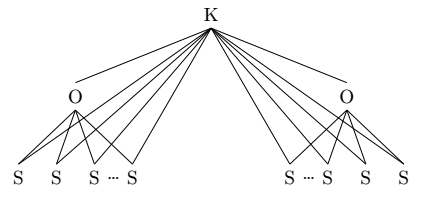
Carlson GN (1977). Reference to Kinds in English. Ph.D. thesis, University of California.
\begin{document}
\begin{tikzpicture}
\node (a)
child
child ;
\path (d) -- (e) node [midway] ;
\path (f) -- (g) node [midway] ;
\path[every node/.style=]
(a.south) edge node (b.north)
(a.south) edge node (c.north)
(a.south) edge node (d.north)
(a.south) edge node (e.north)
(a.south) edge node (f.north)
(a.south) edge node (g.north)
(a.south) edge node (h.north)
(a.south) edge node (i.north);
\end{tikzpicture}
\end{document}
Raising and control Infl (Diesing, 1992)
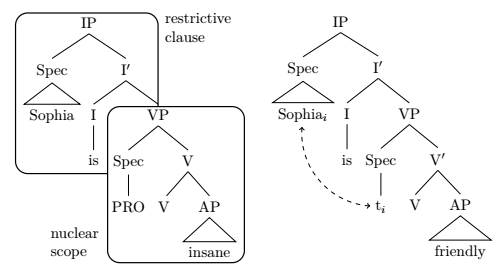
Diesing M (1992). Indefinites. MIT press.
\usetikzlibrary
\begin{document}
\begin{tikzpicture}
\tikzset
\Tree [.\node(ip);
[. \edge[roof]; \node(subj); ]
[.\node(ibar);
[.\node(i); \node(aux);]
[.\node(vp);
[.\node(specvp); \node(subj-t); ]
[.V \node(v);
[.AP \edge[roof]; \node(adj); ]]]]]]]
\begin{scope}
\draw[thick, rounded corners=8pt,fill=white] () rectangle ();
\node[yshift=-1em, xshift=-1.8em, text width=2cm] at (current bounding box.north east) ;
\draw[thick, rounded corners=8pt,fill=white] () rectangle ();
\node[yshift=1.3em, xshift=5.2em,text width=2cm] at (current bounding box.south west) ;
\end{scope}
\end{tikzpicture}
~
\begin{tikzpicture}
\Tree [.\node(ip);
[.Spec \edge[roof]; \node(subj); ]
[.\node(ibar);
[.\node(i); \node(aux);]
[.\node(vp);
[.\node(specvp); \node(subj-t) ;]
[.\node(vbar); \node(v);
[.AP \edge[roof]; \node(adj);] ] ] ] ]
\draw[dashed, <->] (subj-t) [in=-90, out=-90, bend left=45] to (subj);
\end{tikzpicture}
\end{document}
Copular small clause

A tree diagram of the elements of a copular clause.
\usetikzlibrary
\begin{document}
\begin{tikzpicture}
\Tree [.\node(ip);
[.Spec \edge[roof]; \node(subj); ]
[.\node(ibar);
[.\node(i); \node(aux);]
[.\node(vp);
[.\node(specvp); \node(subj-t) ;]
[.\node(vbar); \node(v);
[.AP \edge[roof]; \node(adj);] ] ] ] ]
\begin{scope}
\draw[thick, rounded corners=8pt,fill=white] () rectangle ();
\node[yshift=1.3em, xshift=3.8em,text width=2cm] at (current bounding box.south east) ;
\end{scope}
\draw[dashed, ->] (subj-t) [in=-90, out=-90, bend left=45] to (subj);
\end{tikzpicture}
\end{document}